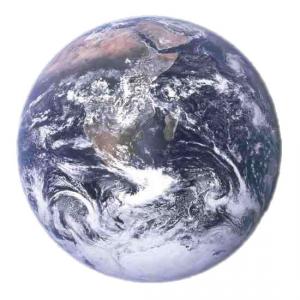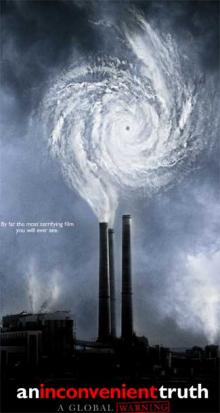 I asked one question to leading environmentalists who are usually keen to point out what is wrong with the environment: What is the good news in the last dozen years for planet Earth?
I asked one question to leading environmentalists who are usually keen to point out what is wrong with the environment: What is the good news in the last dozen years for planet Earth?
Historically there is good news. Within two years of the first Earth Day in 1970 a slew of major legislation was passed — the Clean Air Act, the Clean Water Act, establishment of the EPA, the ban on DDT, and the reduction of lead from paint — all of which delivered monumental benefit to the environment.
But what have we done for the planet lately? Here are the top seven favors we’ve done for Mother Earth in the last 12 years …
The #1 Good News Trend: Action on Global Warming
Lisa Jackson, the new Administrator of the Environmental Protection Agency, joins the majority of those I spoke to in giving the nod to the new worldwide public consensus that has developed around Global Warming.
“In the last decade the world has united around tackling climate change, which will impact people from Micronesia to the Florida Keys to the Sahara. There is a growing, global commitment to fight climate change
and build a green economy. That will lead to further cooperation among nations to tackle other threats to our health and our planet – and that is truly good news for our Earth.”
Randy Serraglio, of the Center for Biological Diversity, agrees. “In the last decade a consensus has emerged within the international scientific community that global climate disruption is underway, is caused by humans, and threatens very serious consequences if we do not deal with it.” The good news, says Serraglio, is the consensus has pushed even corporations toward aggressive action to ward off the worst of those consequences.
 The editorial staff at Treehugger recognized Al Gore’s Oscar-award-winning movie An Inconvenient Truth and the UK’s Stern Report as major influences. “These two events have done much more to engage the general populace to really acknowledge the environmental pressures we face than have decades of dry reporting and NGO ‘the-sky-is-falling’ campaigning.” The worldwide Live Earth concerts, staged around the world on 07.07.07, added to the “positive tipping point” for climate change to become a mainstream media topic.
The editorial staff at Treehugger recognized Al Gore’s Oscar-award-winning movie An Inconvenient Truth and the UK’s Stern Report as major influences. “These two events have done much more to engage the general populace to really acknowledge the environmental pressures we face than have decades of dry reporting and NGO ‘the-sky-is-falling’ campaigning.” The worldwide Live Earth concerts, staged around the world on 07.07.07, added to the “positive tipping point” for climate change to become a mainstream media topic.
The Natural Resources Defense Council says one of the top events of the decade was the EPA’s landmark affirmation this month formally announcing that global warming pollutants are a threat to public health. “By announcing that carbon and other global warming pollutants pose a threat to public health, EPA sets in motion the process of regulating those pollutants, which has to be one of the major advances in public health and environmental protection since the 1970s.”
Consensus grew out of the United Nations in 2007 when nearly 200 countries agreed to accelerate the elimination of chemicals that threaten the ozone and exacerbate global warming. United Nations Environmental Program chief Achim Steiner hailed the agreement by governments, especially China who moved quickly to ban dangerous hydrochlorofluorocarbons, as a “vital signal” in efforts to slow climate change.
“Historic is an often over-used word but not in the case of this agreement made in Montreal,” said Steiner. “It is perhaps the most important breakthrough in an international setting for at least five or six years.”
#2 Positive Development: Renewable Energy Hits its Stride
Nick Nuttall, a spokesperson for the UNEP sees a new era of commitment to green causes. “The international community has rolled out a wide range of un-brokered agreements over the years designed to tackle biodiversity loss, climate change, chemical pollution, ozone layer loss and desertification. Previously, the scale of the response had failed to match the magnitude of the challenge. But over the last 12 months some countries have begun to factor-in the economic costs of environmental degradation and seize the opportunities of transiting to resource efficient, low carbon societies. If this can be scaled up and accelerated and the three trillion dollars-worth of stimulus packages can be spent wisely and creatively, there is now the chance for a transition to a truly Green 21st century economy.”
In answering our survey, Jeff Mikulina, Executive Director of the Blue Planet Foundation and former director of the Sierra Club in Hawaii, naturally wanted to nominate the tremendous progress and growth in clean energy development — solar and wind, in particular. But, Blue Planet is not the only group (non-profit or commercial) to spring up in the past decade powered up by a mission to end the use of fossil fuels.
Treehugger also gave a nod in this direction arguing, “We have finally reached the point where renewable energy from solar and wind have hit the competitive pricing point.”
#3 The Internet: a Greening Force
Jane Goodall, the famous Primatologist and anthropologist, thinks the fact that so many people are using their lives to make a difference, every day, is most amazing and worthy of note. Helping them make this change has been the rise of the World Wide Web.
“I believe the most most positive trend has been the rapid and organic growth of communications technologies,” says Blue Planet‘s Mikulina. “While this ‘tech” might seem antithetical to the theme of low-energy use and sustainability, the power to connect with people and share information has proven a potent tool for social change.”
 It is far easier today to organize individuals and groups with shared values and direct that energy toward democratic action, especially with YouTube, Facebook and blogging. Treehugger points to the use of tools like Digg, Stumble Upon, and Twitter as critical for broadcasting seeds of motivation across a wide area. “Green bloggers are reaching an ever increasing audience, partly by working with their peers/competitors to push green stories in front of many, many eyes.”
It is far easier today to organize individuals and groups with shared values and direct that energy toward democratic action, especially with YouTube, Facebook and blogging. Treehugger points to the use of tools like Digg, Stumble Upon, and Twitter as critical for broadcasting seeds of motivation across a wide area. “Green bloggers are reaching an ever increasing audience, partly by working with their peers/competitors to push green stories in front of many, many eyes.”
“The ability to more easily create and share content enables more people to participate in networks, access a broader knowledge base, and engage in activities that reward the value of collective action,” said Mikulina. “Connections, information and communication, I believe, are fostering greater awareness and hope, and making our living on Earth more sustainable.” (Image above, by Ryan O. Hicks, Perdue University)
#4 Protecting the Amazon
For the World Wildlife Fund (WWF), the best news for planet Earth came in 2002 when WWF partnered with the Brazilian Government and others to launch the world’s largest tropical forest conservation program. The clumsily named Amazon Region Protected Areas program carves out 12 years of strict preservation and sustainable use reserves, including the establishment of over 62 million acres of new protected areas – a swath about the size of Wyoming. The final phase will be implemented beginning in 2009 and will create 50 million acres of newly protected land. Comparable to the U.S. National Park System, yet 50 percent larger, the program will surpass the U.S. National Wildlife Refuge System in sheer numbers of bird, mammal, fish, reptile, and amphibian species protected.
#5 Getting the Lead Out
Effective January 1, 1996, the Clean Air Act banned the sale of the small amount of leaded fuel that was still available in some parts of the country for use in on-road vehicles. In addition, from 2001-2008, a suite of EPA diesel rules will collectively reduce diesel particulate soot and smog-forming pollution by more than 90 percent.
“This is the biggest vehicle pollution news since the removal of lead from gasoline, and will lead to the most significant national public health advance in a generation, said Richard Kassel, director of NRDC’s Dump Dirty Diesel’s campaign. “In terms of cost-effectiveness to the public health, this suite of rules is the biggest regulatory advance in the last 40 years. Collectively, these rules will, by 2030, prevent more than 21,000 premature deaths and more than $160 billion in health costs annually.”
#6 Higher Fuel Efficiency Standards, At Last
Congress strengthened vehicle fuel-efficiency standards for the first time in 30 years with the passage of the Energy Independence and Security Act on December 18, 2007. The bill includes measures to save Americans money at the gas pump and cut down on global warming pollution. “We handed Congress an ambitious agenda at the beginning of 2007, and the bill represents real progress in achieving cleaner cars, fuels, and appliances,” said Karen Wayland, legislative director at NRDC.
The Act sets a goal for the national fuel economy standard of 35 miles per gallon (mpg) by 2020, an increase of 40 percent that would also save the country billions of gallons of fuel.
#7 Sweeping Conservation of Wild Lands by Clinton, Obama — and Bush
Each of the last three presidents, Barack Obama, George W. Bush and Bill Clinton have left a major mark on land use and conservation in the United States. Starting with Clinton, the NRDC points to his historic issuance of the Roadless Rule (Roadless Areas Conservation Rule), which protected 58.5 million acres of unspoiled national-forest land in 39 states from virtually all road building and logging.
 In Bush’s final days in the White House, a stroke of his pen designated three new areas in the Pacific as Marine National Monuments to create the largest area of ocean protection in the world, measuring 195,000 square miles and preventing the destruction of some of the world’s most pristine natural resources, rich in biodiversity. The three areas include the Mariana Trench and the waters surrounding three uninhabited islands in the Northern Mariana Islands, Rose Atoll in American Samoa and seven islands along the equator in the central Pacific Ocean. Bush had created the largest protected marine sanctuary in the world once before, two and a half years earlier, preserving nearly 140,000 square miles in the Northwestern Hawaiian Islands. Home to 7000 marine species, at least a quarter of which are found nowhere else, the expansive Papahanaumokuakea Marine National Monument is larger than all US National Parks combined, stretching a distance not unlike Chicago to Florida.
In Bush’s final days in the White House, a stroke of his pen designated three new areas in the Pacific as Marine National Monuments to create the largest area of ocean protection in the world, measuring 195,000 square miles and preventing the destruction of some of the world’s most pristine natural resources, rich in biodiversity. The three areas include the Mariana Trench and the waters surrounding three uninhabited islands in the Northern Mariana Islands, Rose Atoll in American Samoa and seven islands along the equator in the central Pacific Ocean. Bush had created the largest protected marine sanctuary in the world once before, two and a half years earlier, preserving nearly 140,000 square miles in the Northwestern Hawaiian Islands. Home to 7000 marine species, at least a quarter of which are found nowhere else, the expansive Papahanaumokuakea Marine National Monument is larger than all US National Parks combined, stretching a distance not unlike Chicago to Florida.
Less than one month ago, Obama signed into law one of the most sweeping conservation and public land management bills in years. The legislation will protect 2 million acres of wilderness across the country, including 1,000 miles of wild and scenic rivers, by creating a national system to conserve land held by our Bureau of Land Management.
Reaching Beyond the Environmental Movement
Long established environmental groups have had to evolve too. With years of litigation under their belt and societal change swirling around their computers, environmental activists and conservation organizations are realizing that to achieve fundamental and lasting change, they cannot continue to work exclusively within a narrow slice of politics and culture.
 “If we are at odds with other progressive elements in society, or even if we just ignore their perspectives and concerns or fail to make the effort to gain their support, we risk undermining or stalling progress on environmental issues,” the Center for Biological Diversity‘s Randy Serraglio told the Good News Network. “Conservation groups are increasingly working in coalition with labor, human rights, and other groups to achieve the common goal of a just and healthy world.”
“If we are at odds with other progressive elements in society, or even if we just ignore their perspectives and concerns or fail to make the effort to gain their support, we risk undermining or stalling progress on environmental issues,” the Center for Biological Diversity‘s Randy Serraglio told the Good News Network. “Conservation groups are increasingly working in coalition with labor, human rights, and other groups to achieve the common goal of a just and healthy world.”
Mark Tercek, president and CEO of The Nature Conservancy is a believer in the maxim that necessity is the mother of invention. “We are in the midst of the kind of necessity in which the Conservancy excels and is most inventive. A glance at the highlights of
the last 10 years only hint at what is possible in the coming years: conservation on a grander scale, more ambitious partnerships, an increased integration of human well-being into conservation and an expansion of market solutions across continents and the planet.”
Like EPA Administrator Jackson pointed out, “That is truly good news for our Earth.”





















Thank you for this one! I needed to read this today.
Excellent job, Geri. This truly is Good News.
I heard that Bush had repealed Clinton’s roadless rule and that Obama so far is continuing what Bush started. Anyone have further clarification?
Hi K, I contacted the NRDC to ask about this and here is the latest on the Roadless Rule:
Not everyone supports the benefits of protecting our wild lands. From its first days in office, George W. Bush’s administration worked to weaken protections for roadless areas and give developers access to areas preserved by the Roadless Rule.
The NRCD says, “President Bush illegally exempted Alaska’s Tongass National Forest from the roadless rule as far back as 2001. After eight years of litigation and political wrangling, in its final days, his administration was able to push through exemptions for large portions of the US forest system. They include the Tongass, as well as forests in the state of Idaho and potentially Colorado.”
“The Tongass lies at the heart of the world’s largest remaining temperate rainforest. With its towering groves of ancient trees, the Tongass supports vibrant populations of eagles, grizzlies, wolves and salmon.”
“The roadless rule has proven incredibly successful — only 7 miles of roads have been built in roadless areas since the plan went into effect in 2001. NRDC has urged President Obama’s administration to work quickly and restore protection to the areas left open to assault by his predecessor.”
On March 31, 2009, dozens of leading scientists, including luminaries such as E.O. Wilson, sent the Obama administration a letter supporting the roadless rule
Learn more about the roadless rule from the NRDC:
http://www.nrdc.org/land/forests/qroadless.asp
Learn more about the threat to the Tongass and how you can help save it
at NRDC’s Save BioGems site:
http://www.savebiogems.org/tongass/
Designating vast areas of the Amazon as “protected” is wonderful. In a few years, perhaps you can give us the good news that the law is somehow being enforced. Illegal logging and other abuses are common in that part of the world. I am sure the WWF will help keep tabs. Hopefully violations will be kept to a minimum.
It is similar with any vast area, like Bush’s reserve in the Pacific. If there are commercial uses for that area, protection will be difficult.